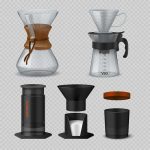Evolving Consumer Preferences in the U.S. Coffee Scene
The American coffee landscape is changing quickly, especially as we move past 2025. Consumers across the U.S. are becoming more selective about what’s in their cup—and where it comes from. These shifting preferences are creating new opportunities and challenges for both independent coffee shops and larger franchise chains.
Growing Demand for Artisanal and Specialty Drinks
One of the biggest trends shaping the future of coffee shops is the rising demand for artisanal drinks. Many customers now seek handcrafted beverages made with high-quality beans and unique brewing techniques. This includes everything from pour-over coffee to nitro cold brews and espresso-based drinks with locally sourced ingredients.
What Customers Are Looking For:
| Preference | Description |
|---|---|
| Artisan Quality | Handcrafted beverages with attention to detail |
| Unique Flavors | Creative seasonal or regional drink offerings |
| Brew Method Variety | Options like pour-over, French press, or siphon brew |
Sustainability Matters More Than Ever
Sustainability has become a major factor influencing where people choose to get their coffee. U.S. consumers are paying more attention to how their drinks impact the environment. They favor businesses that use eco-friendly packaging, offer plant-based milk alternatives, and support fair trade sourcing.
Sustainable Practices That Attract Customers:
| Sustainable Practice | Customer Impact |
|---|---|
| Compostable Cups & Lids | Lowers environmental footprint, aligns with eco-conscious values |
| Dairy Alternatives (Oat, Almond, etc.) | Cater to health-conscious and vegan lifestyles |
| Direct Trade Coffee Beans | Supports ethical farming and transparency in sourcing |
The Push for Local Sourcing and Community Connection
A growing number of Americans want to support local businesses that invest in their communities. Independent cafes often have an edge here, offering regionally roasted beans, baked goods from neighborhood bakeries, and even featuring local artists or musicians. Franchises are beginning to adapt by incorporating more localized elements into their operations, but independents often feel more authentic in this space.
The Local Advantage:
- Community Support: Shops that engage with local events or causes build strong customer loyalty.
- Authentic Experience: Personalized service and a unique vibe set independents apart.
- Regional Identity: Menus that reflect local tastes create stronger connections with customers.
This shift in consumer expectations is reshaping how coffee shops operate across the U.S.—and it’s only just getting started.
2. Technology and Innovation: Leveling the Playing Field
Technology is changing the way coffee shops operate, and its helping both independent cafés and big-name franchises stay competitive. From mobile ordering to AI-powered personalization, these tools are no longer just for corporate giants—they’re becoming accessible to small businesses too. Let’s take a closer look at how technology is shaping the U.S. coffee scene post-2025.
Mobile Apps and Ordering Systems
Mobile apps are becoming a must-have for coffee shops. Customers love the convenience of ordering ahead, customizing drinks, and earning rewards without waiting in line. While franchises like Starbucks have had custom apps for years, new platforms now allow independent shops to offer similar features through third-party services.
| Feature | Franchises | Independent Coffee Shops |
|---|---|---|
| Custom Mobile App | Branded & built in-house (e.g., Starbucks) | Third-party platforms (e.g., Joe Coffee, Square) |
| Loyalty Programs | Integrated into app with national reach | App-based or punch-card style with local appeal |
Contactless Payments
The shift to contactless payments—like Apple Pay, Google Pay, and tap-to-pay credit cards—accelerated during the pandemic and remains strong. Both chains and indie shops now accept these options as standard. Independent cafés benefit from easy-to-use POS systems like Toast or Square that make setup simple.
Why It Matters:
- Saves time at checkout
- Makes customers feel safer and more comfortable
- Cuts down on cash handling errors
AI-Driven Personalization
This might sound high-tech, but AI-driven personalization is becoming more common—even in smaller operations. Franchises use it to suggest drinks based on past orders or location trends. Independents can do something similar using data from their POS or loyalty apps to tailor promotions or menu items to regulars’ preferences.
Examples of AI Use in Coffee Shops:
- Franchise: Suggests your “usual” when you open the app
- Independent: Sends email offers based on what you’ve ordered before
The takeaway? Technology is leveling the playing field. While big brands still have an edge in budget and reach, independents now have access to affordable tech tools that help them compete—and even stand out—by offering a more personal touch.

3. Community and Culture: The Rise of Localism
As we look toward the future of U.S. coffee shops post-2025, one trend that continues to gain momentum is the growing emphasis on community and local culture. More than just a place to grab a cup of coffee, cafés are increasingly seen as social hubs—spaces where people connect, share ideas, and feel a sense of belonging. This shift is giving independent coffee shops a unique advantage over national franchises.
Across the United States, consumers are craving authenticity. They want their neighborhood coffee shop to reflect the vibe and values of their local community. Independent cafés often deliver just that, offering locally roasted beans, regionally inspired décor, and events that bring people together. Whether its open mic nights, art shows featuring local artists, or partnerships with nearby farms and bakeries, these personal touches make independent shops stand out.
Why Localism Matters
The rise of localism isnt just about aesthetics—its deeply tied to consumer values. Many Americans are becoming more intentional about where they spend their money, choosing businesses that align with ethical sourcing, sustainability, and community support. Independent coffee shops can more easily adapt to these values because theyre not bound by corporate policies or mass-market strategies.
Key Differences Between Independents and Franchises
| Feature | Independent Coffee Shops | Franchise Coffee Shops |
|---|---|---|
| Community Engagement | High – Often host local events and collaborations | Moderate – Limited by brand guidelines |
| Customization & Creativity | High – Unique menus and interior designs | Low – Standardized offerings nationwide |
| Local Sourcing | Common – Frequently use local ingredients and roasters | Rare – Centralized supply chains for consistency |
| Cultural Relevance | Strong – Reflects neighborhood identity and trends | Weak – Uniform branding across locations |
The Role of Digital Communities
Even in an increasingly digital world, people seek offline experiences that feel real and rooted in their surroundings. Social media has amplified this desire—customers love sharing photos of cozy café corners or latte art from their favorite local spot. Independent coffee shops benefit from this organic marketing because each shop offers something visually distinct and personally meaningful.
Looking Ahead
If current trends continue, we can expect even more emphasis on hyper-local branding within the coffee industry. Independent shops that build strong community ties and offer unique customer experiences will likely thrive in the post-2025 landscape. As Americans place greater value on connection and authenticity, “local” may become the new gold standard for success in the café world.
4. Franchise Power Plays: Dominance Through Scale and Efficiency
As the U.S. coffee landscape evolves beyond 2025, major franchises like Starbucks, Dunkin’, and Dutch Bros are doubling down on what they do best: scaling up operations, leveraging strong brand recognition, and delivering consistent experiences. While independent shops may win hearts with unique offerings, franchises are winning market share by optimizing efficiency and reach.
Economies of Scale: Saving Big While Growing Fast
Franchises benefit from bulk purchasing power and standardized processes. Whether its sourcing coffee beans or distributing cups and stirrers, buying in large quantities reduces per-unit costs. This means a franchise can offer competitive pricing without sacrificing profit—something most independent cafés struggle to match.
| Advantage | Franchises | Independent Cafés |
|---|---|---|
| Cost of Goods | Lower due to bulk buying | Higher due to smaller orders |
| Supply Chain | Streamlined and centralized | Often local and less predictable |
| Menu Consistency | Standardized across locations | Varies by shop and season |
Marketing Muscle: National Reach Meets Local Appeal
Big coffee franchises have deep pockets for advertising. From national TV commercials to targeted social media campaigns, their brand presence is hard to ignore. Loyalty apps, seasonal drink drops, and influencer partnerships keep customers engaged year-round. Meanwhile, independents often rely on word-of-mouth or grassroots marketing that doesn’t scale as easily.
Loyalty Programs Drive Repeat Business
A key part of the franchise strategy is digital loyalty programs. Starbucks Rewards, for instance, boasts over 30 million active members in the U.S., offering perks that encourage frequent visits—such as free drinks, birthday rewards, and exclusive product access.
Consistency is Key: What You Expect Is What You Get
In today’s fast-paced world, many consumers value knowing exactly what theyre getting—especially when traveling or short on time. Franchises deliver consistency in taste, service, and environment across locations. This reliability makes them a default choice for busy commuters or casual coffee drinkers who want no surprises with their cup.
The Franchise Formula at Work:
- Training: Staff are trained using standardized programs that ensure consistent service quality.
- Design: Store layouts and decor follow brand guidelines for a familiar feel nationwide.
- Product Development: New items are tested at scale before launch to ensure wide appeal.
This strategic mix of scale, marketing strength, and dependability allows franchises to maintain—and even grow—their dominance in a shifting coffee culture that continues to demand both innovation and familiarity.
5. The Future Landscape: Coexistence or Competition?
As the U.S. coffee shop industry evolves beyond 2025, a key question arises: will independent coffee shops and national franchises compete head-to-head, or will they find ways to thrive side by side? The answer may lie in how each adapts to shifting consumer expectations, emerging technologies, and local market dynamics.
Changing Consumer Preferences
Today’s coffee drinkers care about more than just caffeine. Theyre looking for quality, experience, sustainability, and community. Many independents already cater to these preferences with locally-sourced beans, cozy atmospheres, and personalized service. On the other hand, franchises are catching up fast—integrating digital ordering systems, loyalty apps, and eco-conscious practices to stay relevant.
Technology as a Leveler
Technology could be a bridge rather than a barrier between independents and franchises. Mobile payments, AI-driven customer insights, and advanced espresso machines are becoming more accessible. This means even smaller shops can offer fast service and customization at scale—areas previously dominated by big chains.
Local vs. Global Appeal
Franchises often win on consistency and convenience across locations, while independents shine when it comes to local flavor and storytelling. Each has its strengths. Rather than replacing one another, its likely they’ll serve different customer segments within the same city or neighborhood.
Potential Future Scenarios
| Scenario | Description | Impact on Market |
|---|---|---|
| Increased Competition | Franchises expand aggressively into urban and suburban areas traditionally dominated by independents. | Tougher environment for small shops; focus shifts to niche offerings and hyper-local branding. |
| Strategic Coexistence | Both models adjust their value propositions—franchises streamline operations while independents focus on unique experiences. | Diverse market with room for both players; consumers benefit from variety. |
| Hybrid Models Emerge | Larger brands adopt indie-style aesthetics and menus; independents form collectives or micro-franchises. | The line between independent and franchise blurs; innovation drives growth across the board. |
Collaborative Opportunities
A growing trend is collaboration instead of competition. For example, some franchises partner with local roasters or host pop-ups featuring indie bakers or artists. These partnerships allow both sides to tap into new audiences while maintaining their core identities.
Looking Ahead
The post-2025 coffee landscape in the U.S. wont be defined solely by who dominates the market—it will be shaped by how businesses evolve together. Whether it’s through cooperation or clever differentiation, there’s room for both independent cafes and major franchises in America’s diverse coffee culture.

